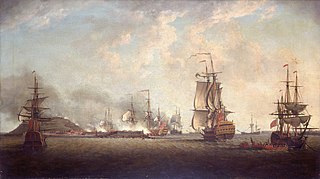The Royal Navy has used the name Comet no fewer than 18 times:
Eleven ships and a shore establishment of the Royal Navy have been named HMS Medway, after the River Medway.
Nine ships of the French Navy have borne the name Redoutable ("Redoubtable"):

Numerous French vessels have borne the name Téméraire. Note that several British ships have had the same name, see HMS Temeraire.
Ten ships of the Royal Navy have borne the name HMS Scarborough, after the town of Scarborough:

The action of March 1677, also known as the Battle of Tobago, took place on 3 March 1677 between a Dutch fleet under the command of Jacob Binckes and a French squadron commanded by Jean II d'Estrées attempting to recapture the island of Tobago in the West Indies. There was much death and destruction on both sides. One of the Dutch supply ships caught fire and exploded; the fire then quickly spread in the narrow bay causing several warships, among them the French flagship Glorieux, to catch fire and explode in turn which resulted in great loss of life. The French fleet retreated but would make a second attempt to captured Tobago at the end of the year with a much stronger fleet.
Thirteen ships of the Royal Navy have borne the name HMS Vigilant:
Casabianca (Q183) was a Redoutable-class submarine of the French Navy. The class is also known as the "1500-ton class" and were termed in French de grande patrouille. She was named after Luc-Julien-Joseph Casabianca. Launched in 1935, she entered service in 1936. She escaped from Toulon during the scuttling of the fleet there on 27 November 1942, and continued in service with the Allied forces. Casabianca, commanded by Capitaine de frégate Jean l'Herminier, had a role in the liberation of Corsica, and was an important link between occupied France and the Free French government based in Algiers.

Fourteen ships of the French Navy or the Galley Corps of the Ancien Régime or Empire have borne the name Couronne ("crown"):

The Redoutable-class submarines were a group of 31 submarines built between 1924 and 1937 for the French Navy. Most of the class saw service during the Second World War. The class is also known in French as the Classe 1 500 tonnes, and they were designated as "First Class submarines", or "large submarine cruisers". They are known as the Redoutable class in reference to the lead boat Redoutable, in service from 1931 to 1942. The class is divided into two sub-class series, Type I, known as Le Redoutable and Type II, Pascal.

HMS Neptune was a 90-gun second-rate ship of the line of the Royal Navy. She was built under the 1677 "Thirty Great Ships" Programme and launched in 1683 at Deptford Dockyard.
Eight ships of the Royal Navy have borne the name HMS Union:
Seven ships of the Royal Navy have borne the name HMS Hazard:

Glorieux was a 74-gun ship of the line in the French Navy. Built by Clairin Deslauriers at Rochefort and launched on 10 August 1756, she was rebuilt in 1777.
Vénus (Q187) was a Minerve-class submarine of the French Navy, commissioned in 1936, and scuttled at Toulon in November 1942.
Glorieux is a surname. Notable people with the surname include:

Le Centaure was a French Navy Redoutable-class submarine of the M6 series commissioned in 1935. She participated in World War II, first on the side of the Allies from 1939 to June 1940, then in the navy of Vichy France until November 1942. She then returned to the Allied side, operating as part of the Free French Naval Forces. Along with Archimède, Argo, Casabianca, and Le Glorieux, she was one of only five out of the 31 Redoutable-class submarines to survive the war. She remained in French Navy service after World War II, and was decommissioned in 1952.

Le Tonnant was a French Navy Redoutable-class submarine of the M6 series commissioned in 1937. She participated in World War II, first on the side of the Allies from 1939 to June 1940, then in the navy of Vichy France. She was scuttled in November 1942.

Le Héros was a French Navy Redoutable-class submarine of the M6 series commissioned in 1934. She participated in World War II on the side of the Allies until June 1940, and then in the naval forces of Vichy France until she was sunk in 1942..

Le Glorieux was a French Navy Redoutable-class submarine of the M6 series commissioned in 1934. She participated in World War II, first on the side of the Allies from 1939 to June 1940, then in the navy of Vichy France until November 1942. She then returned to the Allied side, operating as part of the Free French Naval Forces. She was one of only five — along with Archimède, Argo, Casabianca, and Le Centaure — out of the 31 Redoutable-class submarines to survive the war. She remained in French Navy service after World War II, and was decommissioned in 1952.
This page is based on this
Wikipedia article Text is available under the
CC BY-SA 4.0 license; additional terms may apply.
Images, videos and audio are available under their respective licenses.





